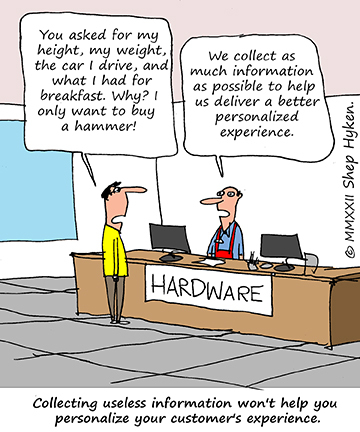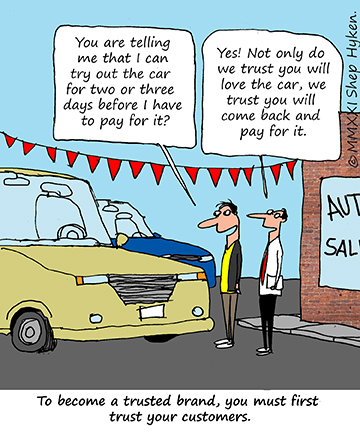Shep Hyken's Blog, page 71
January 10, 2022
5 Top Customer Service Articles of the Week 1-10-2022
Each week I read many customer service and customer experience articles from various resources. Here are my top five picks from last week. I have added my comment about each article and would like to hear what you think too.
A Nation on Hold Wants to Speak With a Manager by Sarah Lyall(The New York Times) The meanness of the public has forced many public-facing industries to rethink what used to be an article of faith: that the customer is always right. If employees are now having to take on many unexpected roles â therapist, cop, conflict-resolution negotiator â then workplace managers are acting as security guards and bouncers to protect their employees.
My Comment: Here is an interesting article from the New York Times about the state of customer service. The general mindset of the customer: patience is wearing thin and tempers are short. And even if that doesnât describe your customers, know that their awareness for what customer service should or should not be is heightened from experiencing lower levels of service due to the pandemic, labor shortage, and higher costs.
Target Delight Instead of Satisfaction | How to Drive Delight the Mercedes-Benz Way by Joseph Michelli(The Michelli Experience) Consumer research shows that up to 75 percent of customers who stop doing business with a company were satisfied or even âvery satisfiedâ when they left. Clearly, when Mercedes-Benz dealers dissatisfy customers â those customers are likely to leave. Unfortunately, when Mercedes-Benz satisfies them â that didnât ensure that they are going to return or recommend the luxury automaker.
My Comment: Mercedes is known for quality, both in the cars they manufacture and the experience they provide. The author of this article, Joseph Michelli, also wrote the book that explains the âsecretsâ behind the way Mercedes-Benz delights its customers. Heâs done the research, and if take the time to read this article (and his book), youâll find ways to delight your customers, as well.
Customer Service Is the New Upsell by David Wagoner(Business 2 Community) We all know that keeping your customers happy is the key to building loyalty and earning repeat business. If your customers arenât satisfied with their buying experience, it wonât matter how good your marketing is, how many leads you receive, or how well your sales funnel converts new customersâthey wonât come back.
My Comment: This article hits two areas. First is the compelling stats and facts around the benefit of repeat business. Yes, thatâs common sense, but understanding the numbers is still important. Second, itâs good customer service to appropriately upsell or cross-sell existing customers. For years Iâve preached that not upselling when itâs right for the customer, is bad customer service.
12 Strategies Businesses Can Use to Show Appreciation for Their Customers by Rolling Stone Culture Council(Rolling Stone) Happy customers are the fuel necessary to run any successful business. To help them is the main reason why many entrepreneurs continue doing what theyâre doing. And when you build a loyal community of customers, you set yourself up with long-term support.
My Comment: How much do we love our customers? And, more than how much we love our customers, how can we show them how much we love our customers? Here are 12 ways from RollingStone.comâs Culture Council panel of experts. Sometimes itâs the simplest ideas that are most effective.
How to Start a Customer Loyalty Program for Your Small Business by Brandi Marcene(Atlanta Small Business Network) Regardless of the industry, youâll come across various issues concerning customer retention. For instance, if you shop for your household items, you may end up encountering customer loyalty programs at some of the most common and popular supermarket chains. The idea behind the implementation and adoption of a customer loyalty program is to increase the benefit exchanged between a business and its customers.
My Comment: If you have ever thought about creating a customer loyalty program, this article can get you pointed in the right direction. And even if the focus is on small businesses, the ideas are good for any size business. Keep in mind that a loyalty program is as much about marketing. Simply put, a good loyalty/marketing program brings in more business.
BONUSTop Sales & Marketing Book 2021 by Top Sales Awards(Top Sales Awards) Despite all the trials, tribulations and challenges this year, we have witnessed the publication of a plethora of excellent books. Some have been penned by seasoned sales experts, with best-sellers already under their belts and others by less well know authors. But it is clear books still play an important role and always will do.
My Comment: It is always an honor to be included on lists of top experts, thought leaders, podcasters, authors, etc. Iâm honored that my most recent book, Iâll Be Back: How to Get Customers to Come Back Again and Again, has been named a Top Sales and Marketing Book for 2021.
[image error]Shep Hyken is a customer service expert, professional speaker, and New York Times bestselling business author. Go to The Customer Focus to learn more about our customer service training programs. Follow on Twitter: @Hyken
to learn more about our customer service training programs. Follow on Twitter: @Hyken
The post 5 Top Customer Service Articles of the Week 1-10-2022 appeared first on Shep Hyken.
January 7, 2022
Guest Post: Should We Encourage Our Customers to Complain?
Josh Liebman is the Guest Experience Evangelist for ROLLER Software, a company that works with leisure and entertainment businesses to help them deliver better guest experiences. He shares the four reasons why businesses should not shy away from customer complaints.
Complaint resolution and service recovery must be a critical aspect of your customer experience strategy. While you may be proactive and attempt to identify any possible friction point in the experience so that it can be resolved before it ever happens, there must be a contingency in place for when the unanticipated happens, and your customers speak up.Â
This requires training and ongoing development of your team to resolve any complaint that comes their way. The more equipped your staff is, the less your customers will hear âlet me get the managerâ or âplease hold while I ask someoneâ when bringing up an issue. With a consistent complaint resolution strategy in place and your staff fully equipped to fix problems, it doesnât mean that complaints will go away. Still, it will make things substantially more manageable, and it ultimately leads to fostering stronger relationships with your customers.Â
But it doesnât mean that every member of your staff will be on board with your strategy. Some are more adept at challenging situations than others. Some might present concerns that resolving complaints only encourages more complaints, creating a snowball effect that grows every time a complaint is received and resolved. If the customer is happy after theyâve complained, it must mean that you are reinforcing the behavior.Â
This seems like a bad thing, but when you pull back, it isnât. The more you encourage your customers to complain, the more your business will grow. Here are four things to consider if you are concerned that you are creating a culture of complaining from your customers: Â
Very few are complaining for the sake of complainingThe biggest concern with encouraging complaints is that it may result in people complaining because they know youâll do something â maybe theyâll get something for free, or theyâll get a refund or a discount on a future purchase. It would seem that this can be long-term damage to your business if word gets out that youâll give away the farm. However, look at the volume of customer feedback you get and separate them into legitimate issues and surface-level whining. Youâll find that the former far exceeds the latter. Even though you may occasionally give something to someone who doesnât deserve it, that shouldnât stop you from solving problems from people who genuinely need it the most. Â
If you verify and document, you have less to worry aboutYour customer communications should always be fully documented, whether positive or negative feedback, including what the outcome was, by whom it was offered and fulfilled, and when the case is closed out. If your records are up to date, a repeat offender will build a track record that you can reference the next time they complain. If they start to show a trend that suggests that this is something theyâve complained about in the past and had it resolved, it allows you to open the conversation to inquire how this is different.Â
And when they realize that youâre catching onto them, they will often pull back.Â
When your recovery is effective, you actually winLetâs say that you get a higher-than-average amount of complaints with questionable legitimacy. One of the most critical components of service recovery is how the issue is resolved, and keep in mind that service recovery isnât just about giving things away for free. It is about restoring a customerâs confidence in your business so that they return and continue to advocate for you. That means that you should examine your offerings and determine what will provide a high value to the customer with minimal or no cost to the business? What can you put in place that will affect their next purchase or visit that will require them to spend more money? The best service recovery is when there is a win-win outcome, and if someone thinks they can pull a fast one on you, youâre actually the winner in the end, even if they feel theyâve won too.Â
You need complaints to improveAll of this leads to the final and most crucial point: you need complaints to improve. You must see your business from the lens of the customer, so you can understand the pain points that you can resolve. If you donât know it, you canât fix it. Every complaint is an opportunity for you to improve, and therefore should be treated as a gift, not a burden. When you are equipped and prepared to deal with issues as they come up, the snowball that builds from enabling a culture of complaints is your growth, not your demise. Â
Donât run from complaints. Run toward them, embrace them, and seek them out at every opportunity. This will allow you to recover from each specific instance while gaining critical intelligence that moves your business into the future.Â
Josh Liebman is the Guest Experience Evangelist for ROLLER Software. With more than 16 years of experience in the attractions industry, Josh specializes in guest experience, including hospitality standards, complaint resolution, and guest feedback.
For more articles from Shep Hyken and his guest contributors go to customerserviceblog.com.
Read Shepâs latest Forbes article: 10 Customer Service And CX Quotes To Inspire And Motivate Your Team
The post Guest Post: Should We Encourage Our Customers to Complain? appeared first on Shep Hyken.
January 5, 2022
Five Lessons On How To Personalize the Customer Experience
 I love to receive great examples of outstanding customer service. Iâm always on the lookout for great stories, whether I personally experience them, or they are sent in by our followers. What I share with you today is a great example of personalized and proactive communication. While I provide the lessons, the example comes from one of our subscribers, Dawn Mushill, who shared a letter that BarkBox wrote to one of its customers.
I love to receive great examples of outstanding customer service. Iâm always on the lookout for great stories, whether I personally experience them, or they are sent in by our followers. What I share with you today is a great example of personalized and proactive communication. While I provide the lessons, the example comes from one of our subscribers, Dawn Mushill, who shared a letter that BarkBox wrote to one of its customers.
BarkBox caters to dog owners and lovers and is a subscription business that sends a box of dog toys and treats to dogs â actually to the dog owners â every month. Recently, some severe tornados caused death and destruction throughout certain parts of the United States. This prompted BarkBox to reach out to its customers in the areas that were hit hardest. This is a letter emailed to one of the customers:
Hello Veronica,
This is Rachel, and my pup Harper, with the Happy Team here at BARK. We’ve been following the news reports on the severe tornadoes that impacted your area and wanted to reach out.
While our mission is to serve dogs and make them happy, you and your family and friends’ wellbeing is equally as important to us. All of us here at BARK are thinking of you and your loved ones and hope that you are safe.
If you need anything at all or know of any pups affected by these tornadoes who might need assistance, we are here to help. We have Bark Eats meals set aside to ship out to pups in need of food. Feel free to reply to this email to get in touch with our Happy Team, who can help get this set up.
We are keeping our eyes on the news and keeping you, your pups, and your community in our thoughts. Please let us know if there is anything else we can do for you!
Warmest regards,
Rachel & Harper
Several lessons from this letter:This is proactive communication at its best. BarkBox reached out with an offer to help if needed.The letter was timely. Immediately after the tornados caused destruction and damage, the letter showed up.The perfect touchpoint. Any time you interact with a customer is a touchpoint. Finding ways to do so outside of the normal process, where you endear yourself to your customers, is a great opportunity. This was the perfect time to engage with the customer.The message from BarkBox wasnât about making a sale. It was about showing care. Just acknowledging that the customers might be in trouble and reaching out to them was a great way to show appreciation.And finally, the most interesting lesson: It was personalized, kind of. Personalization is a hot topic and a powerful way to connect to the customer. But this level of personalization, while extremely powerful, was a result of the customerâs zip code more than anything else. In other words, itâs mass personalization. BarkBox simply sent this letter to all of its customers in the zip codes that experienced potential storm damage. But look at the impact! Iâm sorry if I just revealed how the magic trick works, but itâs so good, and itâs something we can all do, that we need to be reminded how simple it can be to personalize the customer experience.BarkBox gave us a perfect example of showing how to use timely proactive communication and personalization to create a better customer experience.
Shep Hyken is a customer service expert, keynote speaker, and New York Times, bestselling business author. For information on The Customer Focus customer service training programs, go to www.thecustomerfocus.com. Follow on Twitter: @Hyken
customer service training programs, go to www.thecustomerfocus.com. Follow on Twitter: @Hyken
(Copyright © MMXXI, Shep Hyken)
The post Five Lessons On How To Personalize the Customer Experience appeared first on Shep Hyken.
January 4, 2022
Amazing Business Radio: Genefa Murphy
 Intelligent Virtual Assistant
Intelligent Virtual Assistant The Opportunities and Fears Surrounding Intelligent Virtual Assistant
Shep Hyken interviews Genefa Murphy, the Chief Marketing Officer for Five9. They discuss how to use AI and automation to increase efficiency, capacity, and effectiveness within your contact center and ultimately deliver a better customer experience.






 Summary and Top Takeaways:
Summary and Top Takeaways:Do people still use the phone to reach a company when they have a question or a problem?
A lot of companies buy into the “Digital Fallacy” or the belief that digital channels are the only things that matter, and that voice is no longer important. However, The Five9 Customer Service Index 2021 found that:
Customers from the US, UK, Germany, Italy, and Spain all ranked phones as the preferred choice when dealing with customer service issues.51% preferred phone when it comes to general issues.2% prefer phone when it comes to urgent or sensitive concerns.People still use voice channels. What people don’t like about voice channels is the experience. They don’t like waiting on hold, complex IVRs, or conversational AI that doesn’t work.
So, how do we separate the digital channel and the digital experience? How can customers move through different modes of communications, including voice and digital channels, seamlessly without having to repeat their stories?
In this episode, Genefa Murphy talks about Five9’s Intelligent Virtual Agent and how AI can be used to improve communication across all channels.
Tune in to find out just how intelligent the Intelligent Virtual Agent is, how it enhances customer interactions, and if it will take away jobs from human customer support agents down the line.
Quotes:“AI may replace what a human once did but it doesn’t mean that humans need to be replaced in customer support.”
“The digital workforce can free up your agents to work on the things that matter most such as engagements and interactions that require more empathy.”
“Get uncomfortable. Now is the time to reimagine customer experience and take advantage of AI and automation to your benefit.”
About:Genefa Murphy is the Chief Marketing Officer for Five9. With over 15 years of global experience in the field of technology from consulting to product management, strategy, and marketing, she is an accomplished leader and has led worldwide teams in creating and executing compelling and effective go-to-market strategies.
Shep Hyken is a customer service and experience expert,â¯New York Timesâ¯bestselling author, award-winning keynote speaker, and your host of Amazing Business Radio.
This episode ofâ¯Amazing Business Radio withâ¯Shepâ¯Hykenâ¯answers the following questions ⦠and more:
Do people still call customer support?What is an Intelligent Virtual Assistant?What does the digital fallacy mean?Will Intelligent Virtual Assistant replace humans in contact centers?Should every business use AI and automation?The post Amazing Business Radio: Genefa Murphy appeared first on Shep Hyken.
January 3, 2022
5 Top Customer Service Articles of the Week 1-3-2022
Each week I read many customer service and customer experience articles from various resources. Here are my top five picks from last week. I have added my comment about each article and would like to hear what you think too.
How to Train Your Customer Support Agents To Provide Better Service by Kimberly Zhang(Entrepreneur) Customer service begins and ends with the way your employees treat browsers and buyers. Make sure everyone in your company has a toolkit and playbook to make a terrific impression.
My Comment: Iâm always interested in reading articles on customer service training. (Thatâs a big part of what we do at Shepard Presentations.) This article includes four ideas around coaching, empowering employees, communicating the customer experience goals of the company, and starting the employeeâs focus on customer service during their onboarding.
The Seven Types Of Neglected Customers (Two You Know And Five You Donât) by Daniel Rodriguez(Forbes) With continued shipping delays and staffing issues, the ability for companies to actually deliver exceptional experiences to their customers is proving more challenging than ever. This means that customer communications and handling customer inquiries with empathy and attentiveness have never been more important.
My Comment: Customer neglect is a hot topic today. The labor shortage and supply chain issues have caused some companies to unintentionally neglect their customers. Daniel Rodriguez, the CMO of Simplr, describes seven types of neglected customers and their behaviors. Five of these types of customers are, as Rodriguez says, âlurking beneath the surface and negatively impacting your brandâs and bottom line without you knowing it.â
When bad customer service becomes a business opportunity by Joe Williams(Los Angeles Times) Customer support has become a crowded battlefield in enterprise technology as software vendors such as Microsoft Corp. and Salesforce.com Inc. rush to arm organizations with tools to create one-stop service centers.
My Comment: This article is more of an update on the customer service industry. It mentions the biggest companies in the industry that are focusing on solutions for the customer support industry. Those companies include Salesforce, Microsoft, ServiceNow, Genesys, Five9, Avaya, and others. Consider what Vasili Triant, COO of UJET says about customer support centers: âInstead of being a cost center, itâs a lifetime value driver.â Invest in customer support and youâll see it doesnât cost. It pays.
CX Trends That Will Shape Marketing in 2022 by Chad Harwood-Jones(Business2Community) As we enter 2022, itâs the ideal time to set our marketing goals, KPIs and targets for the year ahead.
My Comment: CX and marketing are closely linked. Itâs said that CX is the new marketing. Iâll agree that itâs at a minimum, a big part of marketing, especially if the focus is getting new customers to come back as repeat customers. The author of this article suggests four ideas that all companies should consider: personalization, predictive customer insights, creating trust (this one is BIG), and using video to transform customer engagement.
Biden Administration Made Major Customer Experience Moves in 2021 by Frank Konkel(Nextgov) Major policy changes regarding how federal agencies serve citizens took pace over the past year.
My Comment: I realize people around the world read this roundup, but Iâm going to go âlocalâ and share that the US government is stepping up to provide âthe people,â a better customer service experience. This has been bantered around by prior administrations, but the Executive Order that President Biden recently signed âputs some teeth into it.â Some of the initiatives are very forward thinking and worth reading about. Within the article is a link to the Executive Order. Some of what they plan to do might spark an idea or two for your organization.
[image error] Shep Hyken is a customer service expert, professional speaker, and New York Times bestselling business author. Go to The Customer Focus to learn more about our customer service training programs. Follow on Twitter: @Hyken
to learn more about our customer service training programs. Follow on Twitter:Â @Hyken
The post 5 Top Customer Service Articles of the Week 1-3-2022 appeared first on Shep Hyken.
December 31, 2021
Guest Post: Why You Should Rethink Your Customer Service Goals
Karen Hertzberg is the Senior Content Marketing Specialist at Siege Media. She shares 5 customer service strategies that improve customer retention.
People may cut companies some slack if a product doesn’t quite work as expected, but only when the customer service experience makes up for these missteps.
It’s no secret that customer service is a critical component of any successful company’s strategy. Whether you offer a service, product, or anything in between, your customer service needs to effectively support your customers.
What’s the main reason that customer service is so important? It’s a driving force behind customer retention and satisfaction. That’s why 83% of experts agree it’s far more beneficial (and cost-effective) to keep an existing customer happy than to gain a new one.
What is Customer Retention?Customer retention refers to a company’s ability to create loyal repeat customers. These customers are more likely to turn to your company when they need what you’re offering and they’ve built an affinity for your brand.
Why is Customer Retention So important?Customer retention is often overlooked because companies hyperfocus on customer acquisition, which is the process of gaining new customers.
It’s a short-sighted strategy to focus on customer acquisition vs. retention. Even if you’re able to acquire customers, if you can’t keep them, eventually your pool of consumers will dry up.
Not being able to retain customers is a red flag that there’s something missing in your business strategy. If you ignore this, it will snowball and create more problems.
When you focus on retention, customer acquisition improves in the long run. You create satisfied customers who are more likely to recommend your company to others. That means retention strategies not only help you keep existing customers but also help build your customer base.
One customer who makes several purchases over time is more valuable than a new customer who makes a single purchase.
5 Customer Service Strategies That Improve RetentionMaybe you’ve realized that you need to make some adjustments to elevate your company’s customer service and improve customer retention. But where should you start?
Gather Data from the StartConsumer data should inform your decision-making. While you shouldn’t devote all of your resources to customer acquisition, there is some value in refining your customer acquisition process to support retention goals.
Smooth Out Your Onboarding ProcessProper customer onboarding can increase retention by up to 50%. Make sure that you have a way to guide your customers through each step of the onboarding journey, whether it’s through emails, built-in tutorials, videos, or a combination of strategies.
Be an Open CommunicatorPublicize your customer service efforts to your customers. They should know that you have the infrastructure in place to hear both their compliments and complaints.
Make sure that it’s easy to navigate your website and phone number to reach your customer service representatives. Additionally, offering multiple ways to connect, such as email, phone calls, and chat, makes the experience more user-friendly.
For loyal customers, assigning them a specific representative for all their concerns helps personalize the experience and makes them feel like they have a direct line to your business to feel heard.
Optimize MessagingEmail marketing is one of the most effective ways to reach out and connect with your customers. But you need to strike a balance in how often you communicate with your customers.
If your emails aren’t frequent enough, then your customers will lose touch with your brand. You’ll become forgettable. But on the flip side, if you flood your customers’ inboxes, they’re going to unsubscribe from your mailing list.
Trigger campaigns send out tailored emails to your customers based on their activity on your website. This helps ensure that your business communicates with customers during key moments.
For example, if a customer fills their digital cart then exits your website, a day or so later they’d receive an email urging them not to forget about those items they loved.
It can be tempting to overdo it with trigger campaigns and email marketing in general. Think about what your customers want and need when you’re deciding how to communicate with them.
Treat Customers as EqualsNever underestimate the power of exclusive sales or offerings to help build a positive relationship with your customers.
Many businesses make the mistake of building their strategies with the idea that they have absolute power over how their customers perceive their business.
This is, to some extent, true. Your business has control over customer service interactions, which can leave customers with strong feelings (whether positive or negative) about your business. But people aren’t always predictable.
Exclusive offers reward customers for loyalty, showing that your company values their business and will reward them for it.
Still looking for more ways to shift your customer service strategy and support your customer retention goals? The graphic below debunks some common customer retention myths and shares some statistics to guide your strategy.

Infographic courtesy of CleverTap
Karen Hertzberg is a writer and digital content marketer from the Seattle metro area. Along with consulting on content strategy, she creates effective how-to and thought leadership content for several B2B and B2C companies. Empathy is her superpower, and she’s obsessed with clear, thoughtful written communication.
For more articles from Shep Hyken and his guest contributors go to customerserviceblog.com.
Read Shep’s latest Forbes article: Ten Business Predictions For 2022 (Part Two)
The post Guest Post: Why You Should Rethink Your Customer Service Goals appeared first on Shep Hyken.
December 29, 2021
How Much Do You Trust Your Customers?
 One of our loyal subscribers, Darrell Grant, The CXO at Hightower Wealth Advisors, shared a great story that provides an excellent customer experience learning opportunity.Â
One of our loyal subscribers, Darrell Grant, The CXO at Hightower Wealth Advisors, shared a great story that provides an excellent customer experience learning opportunity.Â
Darrell stopped by a local bakery to pick up some treats for a client. There was a longer than usual line, and some of the customers were becoming frustrated. Apparently, the internet was down so they couldnât ring up sales. The staff was struggling. The customers were frustrated. Thatâs when a staff member asked the customers to please be patient, and they excused themselves for about two minutes, stepping away to discuss the problem.Â
Less than two minutes later they returned with big smiles on their faces. They announced to the customers that there was a problem taking payment, but they were happy to let each customer order what they wanted. All they asked was that the customers leave their names and numbers so they could call when the terminals were working and take payment over the phone. The customers were happy to comply.Â
Consider this. The bakery had a choice. Without the ability to take payment, they could close the bakery, or they could trust that their customers to pay later. Itâs obvious, the team at the bakery took the customer-focused approach.Â
I worked with a well-known restaurant chain. On occasion, a customer would leave their wallet or purse at home. Once the customer realized their dilemma, the team member would nicely say, âEnjoy the meal. Next time youâre in you can pay for it.âÂ
What message do these examples send to their customers? How many businesses do you know that would let you walk out of their store or place an order without paying for it, and then trust you to come back later to pay? In the B2B old, many customers pay 30 or even 90 days (or more) after they are invoiced for whatever they buy, but this is almost unheard of in retail. Â
Iâm not suggesting you put all of your customers on the honor system when it comes time to be paid. There needs to be a structure and process in place. But when there is a choice to be made, trust your customers. Sure, there are a few you canât trust, probably very, very few, so donât punish the 99-plus percent that is honest because of the sins of these very few. Â
When you trust customers, they reciprocate with their trust. Trust is an important and powerful way to build a better relationship with your customers. My friend Dave Horsager, perhaps the foremost trust expert in the world, says, âTrust, not money, is the currency of business and life.â He also says, âA lack of trust is your biggest expense.â If you canât trust your customers, you canât expect them to trust you. Â
Shep Hyken is a customer service expert, keynote speaker, and New York Times, bestselling business author. For information on The Customer Focus customer service training programs, go to www.thecustomerfocus.com. Follow on Twitter: @Hyken
customer service training programs, go to www.thecustomerfocus.com. Follow on Twitter: @Hyken
(Copyright © MMXXI, Shep Hyken)
The post How Much Do You Trust Your Customers? appeared first on Shep Hyken.
December 28, 2021
Amazing Business Radio: Rebecca Morgan
 Calming Upset Customers
Calming Upset CustomersHow Leaders, Managers, and Staff Can Stay Effective During Unpleasant Conversations
Shep Hyken interviews Rebecca Morgan, an international speaker, management consultant, and bestselling author. She wrote the bestseller, Calming Upset Customers that sold more than 250,000 copies. They discuss what leaders and managers can do to help customer service staff manage upset customers and avoid issues in the future.






 Top Takeaways:
Top Takeaways:Are customers more easily upset today than 30 years ago?
People who would have been rational are now less likely to be patient. And people who are not rational or patient, to begin with, now have an even shorter fuse. This can be attributed to many factors including:
The last two years have caused more stress than usual.There is a decline in civility, especially on social media.Customers are projecting anger about things that they have no control over to customer service agents.What can leaders do to help customer service providers manage upset customers?
Be a role model. There are behaviors that leaders need to practice in front of their customers and their employees, such as listening without getting defensive, watching their tone of voice, and being careful with their word choice.Be willing to fire customers who are repeat offenders. Employees will respect their managers and leaders more when they see that they are willing to let go of abusive customers.Train staff properly. Invest in training whether online or in-person to equip your staff with the tools to connect with customers, even the ones that are upset.Don’t throw your staff under the bus. Standing up for your staff is great for morale and loyalty.In this episode, Rebecca Morgan also talks about what customer service providers do wrong when trying to calm upset customers and what managers should do when their staff gets into an altercation with a customer.
Quotes:“Customer service representatives should be future-focused. Think of how you can help customers avoid issues in the future.”
“Empathy deflates the customer’s anger significantly, even when it is as simple as acknowledging what the customer is going through.”
“Know that you can’t appease everyone, so learn not to take everything personally when dealing with upset customers.”
âEmpower your employees to self-coach. Ask questions like, âWhat would you do differently if you can do it all over again?ââ
About:Rebecca Morgan, CSP, CMC, CVP is an international speaker, management consultant and bestselling author. Two of her 28 books have sold more than 250,000 copies each. She’s appeared on 60 Minutes, Oprah, the Wall Street Journal, Forbes.com, CNBC, National Public Radio and USA Today.
Shep Hyken is a customer service and experience expert,â¯New York Timesâ¯bestselling author, award-winning keynote speaker, and your host of Amazing Business Radio.
This episode ofâ¯Amazing Business Radio withâ¯Shepâ¯Hykenâ¯answers the following questions ⦠and more:
Are there more upset customers now than in the past? How do you deal with an altercation between staff and customers?What should managers do when a staff has an altercation with a customer?How can managers and leaders help staff manage upset customers?What do customer service providers do wrong when trying to calm upset customers?The post Amazing Business Radio: Rebecca Morgan appeared first on Shep Hyken.
December 27, 2021
5 Top Customer Service Articles of the Week 12-27-2021
Each week I read many customer service and customer experience articles from various resources. Here are my top five picks from last week. I have added my comment about each article and would like to hear what you think too.
Expert Shares Tips for Managing Online Reviews by Mike Manges(10 Missions Media) Before Yelp and Google, if you had a bad experience at a business, you might mention it in passing to your family or friends, promise never to return to the place that mistreated you and then move on with your life. Or maybe you had a private word with the owner or manager.
My Comment: Iâm often asked about how to handle negative online reviews. The short answer is to always respond quickly, acknowledge the problem, apologize and suggest moving to âDirect Messageâ or phone to discuss the resolution. This article has a few other ideas worth considering. And I love the closing line: âDonât let somebody else tell your companyâs story.â
Five Tips For Creating A Successful AI-Driven Customer Winback Strategy by Raviteja Sidda(CustomerThink) While some churn is inevitable, companies can minimize the churn rate by creating an effective winback strategy to drive loyalty, revenue and cost-effectiveness and leverage this as an opportunity to enhance their product and services.
My Comment: The stats say itâs less expensive to keep customers than to get new ones. But, what happens when the customers leave? This article makes the case that winning your customers back is also less expensive.
Embrace Customer Complaints To Up Your Customer Experience to Excellent by Ken Sterling(Inc. Magazine) “Embrace customer complaints” is probably a cringe-worthy idea to some of you. The thought of negative feedback may trigger something inside of you that frankly, makes you want to crumble up all the papers on your desk or just throw your laptop against the wall. Wait, please, help is on the way.
My Comment: Donât be afraid of customer complaints. Embrace them! Hereâs an excellent article that will help you turn customer complaints into opportunities. The author focuses on data and survey results, which are great for finding out how happy (or not) your customer is.
7 Key Tips for Designing Voice-User Interfaces by Nick Babich(Entrepreneur) Voice-user interfaces (VUIs) allow users to interact with machines using voice alone. They use speech recognition and natural-language processing to enable users to complete some tasks. VUIs have been a part of sci-fi movies for a long time, but recent progress in this field has made those interfaces a daily reality.
My Comment: In Arthur C. Clarkeâs 2001: A Space Odyssey, HAL, the computer could talk in a human-like fashion, yet it still sounded like a computer. Today the verbal communication between customers and computers is becoming indistinguishable from human-to-human conversations. Hereâs an article with some design tips, but will also give you some insight into how powerful interactive AI is going to be.
4 Ways AI Can Improve the Customer Service Agent Experience by Puneet Mehta(destinationCRM) Customers are more abusive than before, taking out frustrations on delayed flights, lost packages, or late meals on agents at staggering rates. Itâs gotten so bad that call centers have been described as free âpsychological counseling centersâ for distraught customers.
My Comment: And speaking of AI, hereâs how AI can help customer support agents versus interacting with customers. Several great strategies are mentioned here, from something as simple as helping to eliminate repetitive tasks to real-time coaching to help manage the interaction between the agent and the customer.
BONUS9 Must Read Books for Marketers to Start 2022 by Drew Neisser(Renegade) Here are 9 marketing books that I recommend for you and your marketing friends.
My Comment: Iâm honored that my most recent book, Iâll Be Back, made Drew Neisserâs list of top marketing books for 2021. (Thank you, Drew!) If you want to get and keep customers, this list has plenty of good suggestions for you to consider. As many of us are taking some time off the last few days of the year, perhaps this is the perfect time to pick up a new book and get ready to take on the New Year.
Shep Hyken[image error] is a customer service expert, professional speaker, and New York Times bestselling business author. Go to The Customer Focus to learn more about our customer service training programs. Follow on Twitter: @Hyken
to learn more about our customer service training programs. Follow on Twitter: @Hyken
The post 5 Top Customer Service Articles of the Week 12-27-2021 appeared first on Shep Hyken.
December 24, 2021
Guest Post: How to Ensure PCI Compliance in Your Call Centerâ¯
Tom Laird is the Founder and CEO of Expivia, a USA-based, 500 seat omnichannel contact center located in Pennsylvania. He shares how call centers can safeguard critical customer data, giving customers peace of mind while reducing risk to your organization.â¯
Cyber security is important now more than ever with cyber-attacks becoming more and more common. As a call center operator, itâs essential for you to protect sensitive cardholder data. Specifically, need to safeguard customer credit card payment data.â¯Â
By ensuring your call center is PCI-DSS compliant, youâll safeguard critical customer data, giving customers peace of mind while reducing risk to your organization.â¯Â
What Is PCI-DSS Compliance?ÂPayment Card Industry Data Security Standard (PCI-DSS) is a security standard for businesses handling major credit cards that are aimed at reducing fraud. It sets a minimum level of security organizations must meet when handling, processing, and storing credit card information.â¯Â
From building a firewall to maintaining information security for call agents, there are 12 requirements organizations need to meet to be compliant. And compliance is evaluated either on a quarterly or annual basis depending on the organization.â¯Â
How to Establish PCI ComplianceÂThe first step you need to take is to conduct a risk assessment of your organization. You should also carry out the self-assessment questionnaire. These will help you see where your weak points are and how you can quickly achieve PCI compliance.â¯Â
Afterward, you need to establish a policy for compliance that uses strong language like âmustâ and âwillâ to ensure follow-through.â¯Â
When building out your policy for PCI compliance, you need to cover these areas:Â
Build and Maintain a Secure Network: Install and maintain a firewall to protect your customer payment data. Establish secure passwords for access. Protect Cardholder Data: Limit storage of cardholder data to the minimum required and never store data after authorization. Encrypt cardholder data when transmitting it over any public network. Maintain a Vulnerability Management Program: Update antivirus software regularly and protect devices against malware. Use secure systems and applications. Implement Strong Access Control Measures: Use strong passwords and only allow agents to access data if necessary (and under surveillance).â¯Â Regularly Monitor and Test Networks: Track access to cardholder data and run tests to ensure infrastructure is secure against attacks. Maintain an Information Security Policy: Keep your entire team on the same page with a detailed policy on how to handle customer data. Security Risks to Avoid in Your Call CenterÂSecurity risks are everywhere these days. From unhappy employees to careless agents to hackers, there are many ways your customer data can fall into the wrong hands. While being PCI compliant is a necessary step toward safeguarding this information, itâs not the only thing you can do to protect your sensitive data.Â
These are a few extra guidelines to follow in your organization to prevent data breaches:â¯Â
Restrict Mobile Phone Use: No agent should have access to their mobile phones while on the call center floor.â¯Â Remove the Auditory QA Process: Customers should enter their private details (like social security and card numbers) directly using keypads on their phones instead. Report Unauthorized Practices: Agents should be trained to look for and report any unusual or risky situations that they discover so management can remedy the situation. Educate Your Agents: Many security breaches happen accidentally due to poor training. Instead, educate your team on best practices to keep your site secure. Use Cloud-Based Telephony Systems: Reroute vital customer information directly to the payment provider instead of collecting it on site. Run Penetration Testing Regularly: You should never assume your systems are secure. Instead, you should run tests to pinpoint weaknesses. Use multiple layers of security: Hackers are continuously looking for new vulnerabilities. Deploy additional security measures to keep your data secure. PCI Compliance Myths to AvoidÂWhile PCI compliance is a great step forward to ensuring your organization is securing customer data, misunderstanding its purpose and what it covers can put you at risk from all sides.â¯Â
 Hereâs the truth behind several PCI compliance myths to help you out.â¯Â
Itâs only for certain types of businesses: It doesnât matter if youâre a small company or you donât focus on e-commerce, if you handle customer credit card data, you need to be compliant.â¯Â You only need to be compliant in certain areas: The pass rate for PCI compliance is 100%. Even if you only fail in one area, you fail completely. Debit card data is exempt: Wrong. Signature debit cards are dual-purpose (functioning on credit and debit cards networks). Both need protection. I donât know I needed to be compliant: Your bank is not required to ask you to be compliant. And you canât opt out of PCI compliance by refusing to sign a contract. The responsibility is on you if your organization handles customer credit card data. Outsourcing PCI Compliance Removes Responsibility: You are still required to hold customer address data, process returns, and chargebacks. You also need to request compliance certificates from vendors annually to ensure PCI compliance. Why Your Call Center Needs to Be PCI CompliantÂAs a business that manages sensitive data, you have an obligation to protect customer information. But, there are many additional reasons to make sure your organization is PCI Compliant:â¯Â
Avoid Fines: Banks can fine you $5000 – $100,000 monthly for PCI violations. Decrease Cyber Attacks: Each step in the PCI compliance process is designed to reduce the instance of cyber threats, keeping your business and data safe. Improve Brand Image: Customers want to work with organizations that keep their data safe. Staying compliant helps ensure youâll gain a reputation for data security. Increased Sales: PCI compliance reduces anxiety for customers sharing sensitive data, meaning more conversions and sales. Alternative Solutions for PCI ComplianceÂBecoming PCI compliant is not cheap. It can often come with a price tag thatâs over 6-figures for the organization. Still, if you handle customer payment data, you need to be compliant. And there can be a lot of anxiety around trying to become compliant.Â
As a result, many organizations choose to outsource payment processing to third-party vendors who are already PCI-DSS compliant. This helps them stay secure while avoiding the steep start-up cost.Â
Just remember, even if you outsource your credit card data processing, youâre still responsible for protecting your customer data. Work with trusted vendors with a history of top-notch security processes and ask them to share (and update) their compliance certifications regularly.â¯Â
Tom Laird is the Founder and CEO of Expivia, a USA-based, 500 seat omnichannel contact center located in Pennsylvania. He is an author and the host of “The Advice from a Call Center Geek Podcast” where he shares over 25 years of experience in all facets of contact center operations.
For more articles from Shep Hyken and his guest contributors go to customerserviceblog.com.
Read Shepâs latest Forbes article: Ten Business Predictions For 2022 (Part One)
The post Guest Post: How to Ensure PCI Compliance in Your Call Center⯠appeared first on Shep Hyken.




